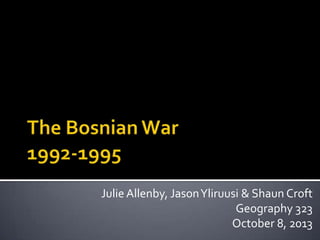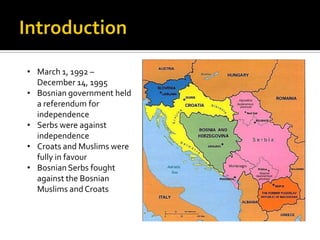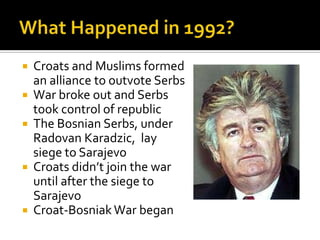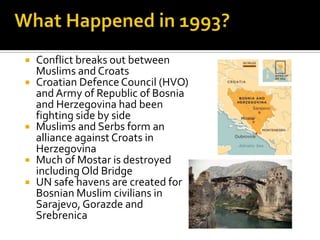The bosnian war
- 1. Julie Allenby, Jason Yliruusi & Shaun Croft Geography 323 October 8, 2013
- 2. • March 1, 1992 – December 14, 1995 • Bosnian government held a referendum for independence • Serbs were against independence • Croats and Muslims were fully in favour • Bosnian Serbs fought against the Bosnian Muslims and Croats
- 3.      Croats and Muslims formed an alliance to outvote Serbs War broke out and Serbs took control of republic The Bosnian Serbs, under Radovan Karadzic, lay siege to Sarajevo Croats didn’t join the war until after the siege to Sarajevo Croat-Bosniak War began
- 5. ÔÇ° ÔÇ° ÔÇ° ÔÇ° ÔÇ° Conflict breaks out between Muslims and Croats Croatian Defence Council (HVO) and Army of Republic of Bosnia and Herzegovina had been fighting side by side Muslims and Serbs form an alliance against Croats in Herzegovina Much of Mostar is destroyed including Old Bridge UN safe havens are created for Bosnian Muslim civilians in Sarajevo, Gorazde and Srebrenica
- 6. ÔÇ° ÔÇ° ÔÇ° The first Markale massacre in Sarajevo occurred The Washington Agreement was signed Croat-Bosniak war officially ended on February 23, 1994
- 7. Safe haven of Srebrenica was overrun by Bosnian Serb forces under General Ratko Mladić  NATO air strikes against Serb positions which helped Muslim and Croat forces  The Army of Republika Srpska (VRS) forces committed the Tuzla massacre on May 25, the Srebrenica massacre and the second Markale massacre on August 28  The Dayton Peace Agreement was officially signed December 14, 1995 in Paris 
- 8. ÔÇ° Bosnia is divided into two semi-independent entities 1. Serb-dominated Republika Srpska (Serb Republic, or RS) 2. The Federation of Bosnia and Herzegovina
- 9. ÔÇ° ÔÇ° ÔÇ° A NATO led Implementation Force (IFOR) was deployed to Bosnia-Herzegovina A decentralized political system was created By the end of 1996, 17 different foreign governments, 18 UN agencies, 27 intergovernmental organizations, and about 200 nongovernmental organizations (NGOs) were involved in reconstruction efforts
- 10. ÔÇ° ÔÇ° There are large discrepancies between estimates of the total number of casualties, ranging from 25,000 to 329,000 Cherif Bassouni, head of the UN expert commission investigating war crimes had originally estimated the death toll to be around 200,000 in 1994
- 11. ÔÇ° ÔÇ° ÔÇ° ÔÇ° ÔÇ° BBC News. 2012. Bosnia-Hercegovina Timeline. http://news.bbc.co.uk/2/hi/europe/1066981.stm Hawton, N. 2009. Conflicting Truths: The Bosnian War. History Today 59 (8). http://www.historytoday.com/nick-hawton/conflicting-truthsbosnian-war Hayden, R.M. 2008. Mass Killings and Images of Genocide in Bosnia. The Historiography of Genocide. Edited by Dan Stone. Palgrave, Macmillan. McMahon, P.C., and Western, J. 2009. The Death of Dayton, How to Stop Bosnia from Falling Apart. Foreign Affairs. http://www.foreignaffairs.com/articles/65352/patrice-c-mcmahon-andjon-western/the-death-of-dayton Macro History and World Timeline. 2005-2013. War in Bosnia. http://www.macrohistory.com/h2/ch35-3.htm











